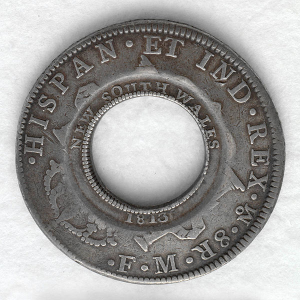Banking (Part 1): A Very Short History – Updated Commentary in TLA
In 1817, Australia’s first bank, the Bank of New South Wales, was established under a charter of incorporation given by the colonial Governor, Lachlan Macquarie. Macquarie saw a bank as being necessary to helping achieve stability in the colonial system of exchange and as ensuring an expanding coinage to underpin economic development. The inherent dialectic – instrument of public/social policy versus market-driven, capital-mobilising facilitator of economic growth – has informed the history of Australian banking.
[caption id="attachment_14289" align="alignright" width="300"] What passed for currency in NSW before Macquarie’s reform. Credit: State Library of New South Wales[/caption]
What passed for currency in NSW before Macquarie’s reform. Credit: State Library of New South Wales[/caption]
It was the growth imperative that prevailed at first. In the 1820s, a spate of banks were formed in NSW and Tasmania (eg Bank of Van Diemen’s Land, Cornwall Bank, Bank of Australia, and Commercial Bank) as the two colonies transitioned from convict-based economies to fully-fledged market economies. Banks contributed to economic development in the colonies by ensuring that money was available for circulation and by raising capital for investment.
Banks in the Australian colonies were also a conduit for the inflow of British finance capital which increased as the nineteenth-century progressed. This contributed hugely to Australia’s economic development, particularly in the period of the “long boom” between the 1860s and 1890s. The downside was that banks were reckless in their lending. Via the banking system, capital exported from Britain flooded into the emerging pastoral industry, and urban land and building development. This led to over-production of wool in the former and rampant speculation in the latter, which contributed mightily to the economic depression that struck Australia in the 1890s. The banks had also maintained insufficient reserves relative to their liabilities and, so exposed, many of Australia’s 22 banks collapsed when the depression hit, intensifying the disastrous impact of the general downturn.
Lack of centralised, national coordination of economic and banking policies in the Australian colonies was a major factor contributing to the 1890s depression. With the twentieth-century and Federation, Australian governments began to assert a mediatory role for themselves within the banking sector. In 1911, the Commonwealth Bank was established by the Fisher Labor Government. Operating primarily as a savings bank, it had an impact on the activities of the established savings banks of State governments but did not seriously threaten private banks. The Federal Government never intended it to supplant the private banks or be a step in establishing government control over the economy generally. Its purpose, rather, was ameliorative: to inject more fairness into the operation of the economy for the benefit of wage-earners, small business people, and small investors and farmers.
While government-owned banks at both Federal and State levels were expected to serve certain “social objectives” (eg providing affordable housing loans), Australian governments were aiming to effectively manage Australia’s capitalist economy rather than transform it. The choices governments made in banking – social considerations versus market forces – were largely determined by the prevailing balance of competing sectional interests and concerns in Australian society at any one time.
In 1924, the conservative Bruce-Page Government legislated to re-form the Commonwealth Bank as a central bank, with powers that included control of the issue of notes, and put the bank under the control of a board whose membership largely consisted of big business representatives, including private bankers. The chair of the board was answerable only to the board and not to the government of the day, effectively limiting government direction over the banking system. In this context in the latter part of the 1920s, Australia’s private banks were able to engage in unsound practices – lending money on slight security, particularly to the farming and manufacturing sectors.
When the Great Depression hit in the 1930s, the ability of the Scullin Labor Government to take remedial financial measures was curtailed by its lack of authority over the Commonwealth Bank and, commensurately, the latter’s ability (particularly in the unfavourable political climate) to effectively dictate economic policy to the Federal and State governments. Under its conservative leadership, the Bank demanded reduced government spending and this programme was accepted by State and Federal governments in the Premiers’ Plan of 1931. This plan provided for a 20 percent reduction in government expenditure translating into cuts to pensions, social services, and the salaries of public servants.
Part 2 of this three-part series on banking in Australia, will examine how these experiences of the Depression and the pressures of war forced a reassessment of both the role of banking and the relationship between the banking system and governments in Australia; a process which continues to this day.
Updated The Laws of Australia Subtitle 18.2 “Types of Financial Institutions” includes consideration of the history of banking in Australia.
For more information about The Laws of Australia, click here.